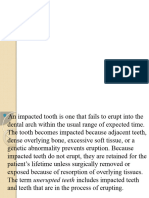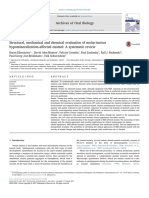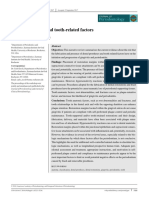Molar Incisor Hypomineralization (MIH) : Clinical Presentation, Aetiology and Management
Molar Incisor Hypomineralization (MIH) : Clinical Presentation, Aetiology and Management
Uploaded by
SelvaArockiamCopyright:
Available Formats
Molar Incisor Hypomineralization (MIH) : Clinical Presentation, Aetiology and Management
Molar Incisor Hypomineralization (MIH) : Clinical Presentation, Aetiology and Management
Uploaded by
SelvaArockiamOriginal Description:
Original Title
Copyright
Available Formats
Share this document
Did you find this document useful?
Is this content inappropriate?
Copyright:
Available Formats
Molar Incisor Hypomineralization (MIH) : Clinical Presentation, Aetiology and Management
Molar Incisor Hypomineralization (MIH) : Clinical Presentation, Aetiology and Management
Uploaded by
SelvaArockiamCopyright:
Available Formats
P A E D O D O N T OP LAOE G
DYO D O N T O L O G Y
Molar Incisor Hypomineralization
(MIH): Clinical Presentation,
Aetiology and Management
K.L. WEERHEIJM
developmental defect responsible for
Abstract: In this paper, the current knowledge about Molar Incisor initiation of the cavity was probably
Hypomineralization (MIH) is presented. MIH is defined as hypomineralization of
not diagnosed.
systemic origin of one to four permanent first molars frequently associated with
affected incisors and these molars are related to major clinical problems in severe
Clinically, MIH molars can create
cases. At the moment, only limited data are available to describe the magnitude of the serious problems for the dentist as well
phenomenon. The prevalence of MIH in the different studies ranges from 3.6–25% and as for the child affected. For dentists,
seems to differ in certain regions and birth cohorts. Several aetiological factors (for the problems are related to
example, frequent childhood diseases) are mentioned as the cause of the defect. unexpectedly rapid caries development
Children at risk should be monitored very carefully during the period of eruption of in the erupting first permanent molar,
their first permanent molars. Treatment planning should consider the long-term inability to anaesthetize the MIH molar
prognosis of these teeth. when treatment is indicated, and
unpredictable behaviour of apparently
Dent Update 2004; 31: 9–12
intact opacities. The child, on the other
Clinical Relevance: This paper relates the current knowledge of MIH to the hand, will experience pain and
clinical appearance of the phenomenon. At the moment, children with a poor general sensitivity (even when the enamel is
health in the first four years after birth should be considered at risk for MIH. intact) creating, for instance, toothache
during brushing. They may also
complain about the appearance of their
incisor teeth.
CLINICAL FEATURES
D uring the past decades, declining
caries prevalence figures have been
noticed in all age groups. In the past,
defects in first permanent molars
during, or soon after, eruption (Figure
1). In the literature, such molars are
MIH is a hypomineralized defect of the
first permanent molars, frequently
dentists were used to rapid caries referred to as non-fluoride enamel associated with affected incisors. The
progression in the primary as well as opacities, internal enamel hypoplasia, number of affected first permanent
the permanent dentition in high caries non-endemic mottling of enamel,
populations. In those days, first opaque spots, idiopathic enamel
permanent molars became carious opacities, enamel opacities and cheese
shortly after eruption in most cases. molars.1,2 Since these molars can be
Although occlusal caries still accounts extremely painful to the children, such
for the majority of caries experience in molars have become a field of renewed
children, a rapid caries progression in interest to clinical practitioners.
first permanent molars is not common Recently, Weerheijm et al. suggested
any more in contemporary populations. the term Molar Incisor
However, dentists (especially paediatric Hypomineralization (MIH) and defined
dentists) are still confronted with large it as hypomineralization of systemic
origin of one to four permanent first
K.L. Weerheijm, DDS, PhD, Department of molars frequently associated with
Cariology Endodontology Pedodontology, affected incisors.3 MIH does not appear Figure 1. 6/ with cavity due to MIH. Notice the
Academic Centre for Dentistry (ACTA), to be a new phenomenon, but when yellow opacities at the cavity border, buccal
Amsterdam,The Netherlands.
caries prevalence was high, the cusps and at the occlusal mesial part.
Dental Update – January/February 2004 9
P AE D O D O N T O L O G Y
opacities are demarcated, unlike the
diffuse opacities that are typical of
fluorosis and by the structure of the
enamel (fluorosis is caries resistant and
MIH is caries prone). The cause of
fluorosis can, mostly, directly be related
to the period in which the fluoride intake
was too high. Choosing between
amelogenesis imperfecta (AI) and MIH as
a diagnosis seems a matter of definition:
it should be stressed that, only in very
severe MIH cases, the molars are equally
Figure 2. White opacity buccal at /1 and white/ affected and mimic the appearance of AI.
yellow opacity buccal at /l and 2/. Mostly in MIH, the appearance of the
defects will be more asymmetrical in the
molars per patient varies from one to four molars as well as in the incisors. In AI,
and expression of the defects may vary the molars may also appear taurodont on Figure 3. /6 with yellow opacities and a cavity
in the distal part of the occlusal surface.
from molar to molar. Within one patient, radiograph and there is often a history of
intact opacities can be found on one family onset.
molar, while in another molar large parts factors mentioned are oxygen starvation
of the enamel break down soon after of the child combined with a low birth
eruption. When a severe defect is found PREVALENCE weight, calcium and phosphate metabolic
within a subject, it is likely that the In epidemiological studies, children are disorders and frequent childhood
contralateral tooth is also affected.4 normally not screened for the existence of diseases.10-12 Vaccines given during early
In some cases, apart from defects in the MIH molars. At the moment, only limited childhood have also been suggested as a
first permanent molars, opacities may be data of prevalence of MIH are available. possible cause but no data are available
found in the upper and sometimes the The prevalence figures range from 3.6– to substantiate this. The use of
lower incisors (Figure 2). The risk of 25% and seem to differ between countries antibiotics has also been implicated, but
defects to the upper incisors appears to and birth cohorts.1,4-8 In the study by antibiotic use is in most cases related to
increase when more first permanent Weerheijm et al.,5 it was found that the occurrence of diseases, so it is difficult to
molars have been affected.5 The defects frequency of MIH molars was not evenly distinguish whether the association with
of incisors are usually without loss of divided among the children in the studied MIH is caused by the antibiotic or by the
enamel substance. population. Of the children where MIH illness itself.
Clinically, the hypomineralized enamel molars were found, about 80% had two or The results of the different studies are
can be soft, porous and look like more affected molars indicating child- not always in agreement with each other.
discoloured chalk or old Dutch cheese. related factors.5 A high impact on Problems during pregnancy and birth
The enamel defects can vary from white treatment need is reported in low caries have been mentioned, while in other
to yellow or brownish but they always prevalence areas resulting from MIH studies no differences were found
show a sharp demarcation between the molars.7,9 concerning the health of mother and child
affected and sound enamel (Figure 3). during pregnancy and birth of the
The porous, brittle enamel can easily chip children with and without MIH.2,12 The
off under the masticatory forces. AETIOLOGY latter indicates a more child-related cause
Sometimes, the loss of enamel (post- The asymmetrical occurrence of MIH originating after birth. The suggested
eruptive enamel breakdown) can occur so molars within individuals suggests that influence of prolonged breast-feeding
rapidly after eruption that it seems as if the ameloblasts are affected by a could not be demonstrated in all
the enamel was not formed initially. After systemic disorder at a very specific stage studies.6,7,12,13 At this moment, we have to
occurrence of the post-eruptive enamel in their development. At the moment conclude that the aetiology of MIH still
breakdown, the clinical pictures can researchers speculate that, in the case of remains unclear. It is likely that several
resemble hypoplasia. In hypoplasia, MIH, the ameloblasts are affected in the unknown contributing factors are
however, the borders to the normal early maturation stage, or maybe even involved resulting in a number of
enamel are smooth, whilst in post- earlier at the late secretory phase. possible causes.
eruptive enamel breakdown the borders In the literature, various causes for
to the normal enamel are irregular. MIH molars, such as environmental
MIH can sometimes be confused with conditions, respiratory tract problems, TREATMENT
fluorosis or amelogenesis imperfecta. It perinatal complications and dioxins have MIH may lead to extensive treatment
can be differentiated from fluorosis as its been suggested.1,2,4,6 Other causative need.7,9 Although children with and
10 Dental Update – January/February 2004
P AE D O D O N T O L O G Y
be chosen for these restorations. The consider children with a poor general
outline of the restoration should be made health in the first four years after birth at
in non-hypomineralized enamel, but it can risk for MIH.12 These children should be
be very difficult to find out where sound monitored more frequently during
enamel begins, resulting in repeated eruption of the first permanent molars.
restorations due to disintegration of The same applies to children at low risk
adjacent enamel or opacities on other of caries when an opacity is noticed at
spots. The disintegration of the the eruption of one of the first permanent
hypomineralized enamel can be molars. Management of these teeth
Figure 4. Lower arch with stainless steel crowns unpredictable in the first years after should consider their long-term
on first permanent molars in child with MIH. eruption. In hypersensitive cases, or very prognosis, as well as management of the
severely affected teeth, semi-permanent presenting features such as pain.
restorations with stainless steel crowns
without MIH showed similar dental (Figure 4) or adhesive-retained metal
histories concerning their primary castings can be an alternative restoration.
dentition, it was found that, after eruption Extraction of such molars, combined with REFERENCES
1. Koch G, Hallonsten A-L, Ludvigsson N, Hansson
of the first permanent molars by the age orthodontic treatment, should be BO, Holst A, Ullbro C. Epidemiologic study of
of nine, children with MIH were treated considered as an alternative treatment, idiopathic enamel hypomineralization in
ten times as often as children without especially if the molars have a poor long- permanent teeth of Swedish children. Community
Dent Oral Epidemiol 1987; 15: 279–285.
such molars.9 The MIH children in this term prospect. The optimal time for 2. Amerongen van WE, Kreulen CM. Cheese molars:
study displayed more dental fear and extraction is indicated by the beginning a pilot study of the aetiology of hypocalcifications
anxiety compared to the healthy control of calcification of the bifurcation of the in first permanent molars. J Dent Child 1995; 62:
group. Adequate use of local anaesthesia roots of the lower second permanent 266–269.
3. Weerheijm KL, Jälevik B, Alaluusua S. Molar-Incisor
is regarded as an important factor to molar (usually around the age of 81/2–91/2 Hypomineralisation. Caries Res 2001; 35: 390–391.
prevent dental fear and the reduction of years). In practice, this will mean 4. Alaluusua S, Lukinmaa P-L,Vartiainen T, Partanen M,
discomfort of the child during treatment.9 extraction of the lower molars followed, Torppa J, Tuomisto J. Polychlorinated dibenzo-p-
The difference in treatment need was half a year later, by extraction of the dioxins and dibenzofurans via mother’s milk may
cause developmental defects in the child’s teeth.
mainly related to the affected teeth.7,9 upper molars. Orthodontic intervention is Environ Toxicol Pharmacol 1996; 1: 193–197.
MIH molars are fragile, and caries may indicated in most cases to optimize the 5. Weerheijm KL, Groen HJ, Beentjes VEVM,
develop easily in these molars. This definitive treatment outcome. Poorterman JHG. Prevalence of cheese molars
problem is aggravated because the Generally, the defects of the incisors in 11-year-old Dutch. J Dent Child 2001; 68: 259–
262.
children tend to avoid the sensitive are milder than those of the molars. Since 6. Alaluusua S, Lukinamaa P-L, Koskimies M, et al.
molars when brushing their teeth. If an masticatory forces on the opacities in Developmental dental defects associated with
erupting first permanent molar shows incisors are absent, the enamel substance long breast feeding. Eur J Oral Sci 1996; 104: 493–
497.
signs of opacities and/or post-eruptive does not disintegrate after eruption.
7. Leppäniemi A, Lukinmaa P-L, Alaluusua S.
breakdown, the child should be However, treatment is often required for Nonfluoride hypomineralizations in the
monitored frequently until the moment aesthetic reasons. In such cases (and in permanent first molars and their impact on the
that all four molars have completely the rare case of breakdown of the treatment need. Caries Res 2001; 35: 36–40.
8. Jälevik B, Klingberg G, Barregard L, Norén JG. The
erupted. In order to minimize the loss of enamel), replacement with composite prevalence of demarcated opacities in permanent
enamel and any damage due to caries, should be considered as first treatment first molars in a group of Swedish children. Acta
both preventive and interceptive option. Odontol Scand 2001; 59: 255–260.
treatment is required. Besides normal The presence of MIH molars not only 9. Jälevik B, Klingberg G. Dental treatment, dental
fear and behaviour management problems in
brushing and education to child and requires the dentist to identify problems children with severe enamel hypomineralization in
parents, prevention also includes fluoride at the earliest opportunity, but also to their permanent first molars. Int J Paed Dent 2002;
varnish application and application of explain the problem thoroughly and 12: 24–32.
glass ionomer sealants. Sometimes the explain the treatment options to the 10. Johnson D, Kreji C, Hack M, Fanaroff A.
Distribution of enamel defects and the
sensitivity of the teeth is decreased by parent and child. As only the first association with respiratory distress in very low
these applications. The first aim should permanent molars (and sometimes the birth weight infants. J Dent Res 1984; 63(1): 59–64.
be relief of pain followed by incisors) are affected by the 11. Jontel M, Linde A. Nutritional aspects on tooth
consideration of the long-term viability of developmental enamel defect, the parents formation. Wld Rev Nutr Diet 1986; 48: 114–136.
12. Beentjes VEMV, Weerheijm KL, Groen HJ. Factors
the molars. If restorative treatment is can be reassured with respect to the involved in the aetiology of Molar-Incisor
indicated, proper local anaesthesia is quality of teeth that have not yet erupted. Hypomineralisation (MIH). Eur J Paediatr Dent
mandatory. The dentist should keep in 2002; 1: 9–13.
13. Jälevik B, Norén JG. Enamel hypomineralisation of
mind that, in some cases, it can be
SUMMARY permanent first molars. A morphological study
difficult to get the molar properly and survey of possible etiologic factors. Int J
anaesthetized. Adhesive materials should In summary, it seems advisable to Paediatr Dent 2000; 10: 278–289.
12 Dental Update – January/February 2004
You might also like
- Training DayDocument158 pagesTraining DayCraescu Radu50% (2)
- Health Statistics and Survey Final Exam, 2023Document3 pagesHealth Statistics and Survey Final Exam, 2023Haccee Tube100% (5)
- 11-Impacted Third MolarDocument117 pages11-Impacted Third MolarAhmed aljumailiNo ratings yet
- McFall 1982 Prognosis SystemsDocument11 pagesMcFall 1982 Prognosis SystemsApril FloresNo ratings yet
- Management of The Compromised First Permanent Molar CG-A010 - 04 UpdatedDocument8 pagesManagement of The Compromised First Permanent Molar CG-A010 - 04 UpdatedmahmoudNo ratings yet
- 56.rapid Breakdown of First Permanent Molars PDFDocument4 pages56.rapid Breakdown of First Permanent Molars PDFmirfanulhaqNo ratings yet
- Biomechanics of The Temporomandibular JointDocument25 pagesBiomechanics of The Temporomandibular JointBianca UngureanuNo ratings yet
- No Objection Cerificate ApplicationDocument4 pagesNo Objection Cerificate ApplicationSelvaArockiamNo ratings yet
- InTech-Molar Incisor Hypomineralization Morphological Aetiological Epidemiological and Clinical ConsiderationsDocument25 pagesInTech-Molar Incisor Hypomineralization Morphological Aetiological Epidemiological and Clinical ConsiderationsNeagu EmaNo ratings yet
- Diagnosis and Treatment of Molar Incisor Hypomineralization-CompressedDocument7 pagesDiagnosis and Treatment of Molar Incisor Hypomineralization-Compressedumipig.tvNo ratings yet
- Evaluating The Changes in Molar Incisor Hypomineralization PrevalenceDocument8 pagesEvaluating The Changes in Molar Incisor Hypomineralization PrevalencelaysatmeloNo ratings yet
- Epidemiologie Study of Idiopathie Enamel Hypomineralization in Permanent Teeth of Swedish ChildrenDocument8 pagesEpidemiologie Study of Idiopathie Enamel Hypomineralization in Permanent Teeth of Swedish ChildrenEnrita DianNo ratings yet
- Toxicologiacal Fluorides PDFDocument404 pagesToxicologiacal Fluorides PDFMoisés MotaNo ratings yet
- Bisphenol A PDFDocument112 pagesBisphenol A PDFJeff PragerNo ratings yet
- Statement of Efsa: European Food Safety Authority (EFSA), Parma, ItalyDocument16 pagesStatement of Efsa: European Food Safety Authority (EFSA), Parma, ItalySandra Ariana100% (1)
- Agricultural Use of Sewage SludgeDocument8 pagesAgricultural Use of Sewage SludgeVenkataLakshmiKorrapatiNo ratings yet
- MIH An OverviewDocument9 pagesMIH An OverviewLaura QuinteroNo ratings yet
- Third Molars: A Dilemma! or Is It?: Clinicians' CornerDocument6 pagesThird Molars: A Dilemma! or Is It?: Clinicians' CornerElizabeth CortésNo ratings yet
- Rehabilitation of Molar-Incisor Hypomineralization (MIH) Complicated With Localized Tooth Surface Loss 2014Document3 pagesRehabilitation of Molar-Incisor Hypomineralization (MIH) Complicated With Localized Tooth Surface Loss 2014player osamaNo ratings yet
- Archives of Oral Biology: ReviewDocument10 pagesArchives of Oral Biology: ReviewEDER YAHIR MONROY MENDOZA100% (1)
- Dentistry: Dentistry Is A Branch of MedicineDocument10 pagesDentistry: Dentistry Is A Branch of MedicineMrWolf23No ratings yet
- 22q11.2 SyndromeDocument6 pages22q11.2 Syndromepopat78No ratings yet
- Dentalindices 150810132800 Lva1 App6892 PDFDocument132 pagesDentalindices 150810132800 Lva1 App6892 PDFNitya KrishnaNo ratings yet
- Dental Plaque - Classification, FormationDocument5 pagesDental Plaque - Classification, FormationRAHMANo ratings yet
- 2013 Gemc Res Lex Dental - Emergencies - and - Blocks OerDocument101 pages2013 Gemc Res Lex Dental - Emergencies - and - Blocks OerMuhammad Azeem KhanNo ratings yet
- Amelogenesis ImperfectaDocument11 pagesAmelogenesis Imperfectamapecorelli2626No ratings yet
- Case Report: Management of A Severely Submerged Primary Molar: A Case ReportDocument4 pagesCase Report: Management of A Severely Submerged Primary Molar: A Case ReportCalvintNo ratings yet
- Management of Impacted Maxillary Canines Using Mandibular AnchorageDocument4 pagesManagement of Impacted Maxillary Canines Using Mandibular Anchoragedrsankhya100% (1)
- Treatment Decisions On Molar-Incisor HypomineralizDocument8 pagesTreatment Decisions On Molar-Incisor HypomineralizAlvaro ChacónNo ratings yet
- Epidemiology of Dental Caries 2020Document58 pagesEpidemiology of Dental Caries 2020zahra.mohmed2816No ratings yet
- Extrinsic and Intrinsic Factors in The Etiology of MalocclusionDocument7 pagesExtrinsic and Intrinsic Factors in The Etiology of MalocclusionNavroop KaurNo ratings yet
- Dental StainsDocument30 pagesDental StainsArtur Radvanszki100% (1)
- Diagnosis and Management of The Infraerupted Primary MolarDocument3 pagesDiagnosis and Management of The Infraerupted Primary Molarsümeyra akkoçNo ratings yet
- Periodontic-Endodontic Lesions PDFDocument6 pagesPeriodontic-Endodontic Lesions PDFdanielaNo ratings yet
- Non-Caries Dental DiseaseDocument61 pagesNon-Caries Dental Diseaseapi-19916399No ratings yet
- Dental AnxietyDocument3 pagesDental AnxietyLau Kien YeeNo ratings yet
- Endo Update 2006 PDFDocument21 pagesEndo Update 2006 PDFRamona MateiNo ratings yet
- Child AbuseDocument16 pagesChild AbuseKynachasya' RiverNo ratings yet
- The Periodontal Pocket: Pathogenesis, Histopathology and ConsequencesDocument8 pagesThe Periodontal Pocket: Pathogenesis, Histopathology and ConsequencesChaudhari Sonali100% (1)
- Delayed Tooth EmergenceDocument16 pagesDelayed Tooth EmergenceValeria CernegaNo ratings yet
- Prolonged Retention, Ankylosis and Infraocclusion of Deciduous Teeth Ok OkDocument5 pagesProlonged Retention, Ankylosis and Infraocclusion of Deciduous Teeth Ok OkRahulLife'sNo ratings yet
- Medical Emergency in Paediatric Dental ClinicDocument75 pagesMedical Emergency in Paediatric Dental ClinicAkshay Sreeraman KecheryNo ratings yet
- Relationship Between Molar Incisor Hypomineralization (MIH) Severity and Cavitated Carious Lesions in SchoolchildrenDocument8 pagesRelationship Between Molar Incisor Hypomineralization (MIH) Severity and Cavitated Carious Lesions in SchoolchildrenAlvaro AragonNo ratings yet
- BSDH Domiciliary Guidelines August 2009Document40 pagesBSDH Domiciliary Guidelines August 2009joquitoNo ratings yet
- Role of A Pedodontist in Cleft Lip and Cleft Palate Rehabilitation - An OverviewDocument25 pagesRole of A Pedodontist in Cleft Lip and Cleft Palate Rehabilitation - An OverviewIJAR JOURNALNo ratings yet
- Periodontal Problems in KidsDocument49 pagesPeriodontal Problems in KidsRaksmey PhanNo ratings yet
- Diagnosis Dilemmas in Vital Pulp Therapy Treatment For The Toothache Is Changing.Document10 pagesDiagnosis Dilemmas in Vital Pulp Therapy Treatment For The Toothache Is Changing.khawla boukhNo ratings yet
- Periodontal Vaccines - A ReviewDocument4 pagesPeriodontal Vaccines - A ReviewdocrkNo ratings yet
- Introduction To Dental Anatomy: Learning Objec TivesDocument12 pagesIntroduction To Dental Anatomy: Learning Objec Tivesbalkiz mahamedNo ratings yet
- Anterior Resin InfiltrationDocument21 pagesAnterior Resin InfiltrationNellin Igop BariasNo ratings yet
- Dental Caries & GeneticsDocument13 pagesDental Caries & GeneticsRenuka PiddennavarNo ratings yet
- Early Childhood CariesDocument26 pagesEarly Childhood Cariesapi-485081343No ratings yet
- Endo Perio RelationsDocument28 pagesEndo Perio RelationsMunish Batra100% (1)
- Dental Prostheses and Tooth-Related FactorsDocument14 pagesDental Prostheses and Tooth-Related FactorsMartty BaNo ratings yet
- Orthodontics 1. Clinical ExaminationDocument8 pagesOrthodontics 1. Clinical Examinationmonica896No ratings yet
- Epidemiologi Dental CariesDocument21 pagesEpidemiologi Dental CariesSampahAjaNo ratings yet
- Hypomineralised Second Primary Molars May Be Indicative of Future Molar Incisor Hypomineralisation PDFDocument6 pagesHypomineralised Second Primary Molars May Be Indicative of Future Molar Incisor Hypomineralisation PDFnha khoa NHƯ NGỌCNo ratings yet
- DR Nick Lekic - Space MaintainersDocument35 pagesDR Nick Lekic - Space MaintainersanatomimanusiaNo ratings yet
- Cattle Cheek InfectionDocument10 pagesCattle Cheek InfectionAiaNo ratings yet
- Tooth Discolour at Ion and StainingDocument8 pagesTooth Discolour at Ion and StainingNilesh S KadamNo ratings yet
- Identifying andDocument9 pagesIdentifying andVinisha Vipin SharmaNo ratings yet
- RoB 2 Guidance Crossover TrialDocument16 pagesRoB 2 Guidance Crossover TrialSelvaArockiamNo ratings yet
- Quadas 2Document11 pagesQuadas 2SelvaArockiamNo ratings yet
- Management of Oral Submucous Fibrosis: by S.Roja PrabhaDocument36 pagesManagement of Oral Submucous Fibrosis: by S.Roja PrabhaSelvaArockiamNo ratings yet
- Evaluation of Various Oral Cancer Diagnostic TechniqueDocument13 pagesEvaluation of Various Oral Cancer Diagnostic TechniqueSelvaArockiamNo ratings yet
- MDS Application FormDocument4 pagesMDS Application FormSelvaArockiamNo ratings yet
- ROBINS-I: A Tool For Assessing Risk of Bias in Non-Randomised Studies of InterventionsDocument7 pagesROBINS-I: A Tool For Assessing Risk of Bias in Non-Randomised Studies of InterventionsSelvaArockiamNo ratings yet
- The Keystone Triad: I. Anatomy, Phylogenetics, and Clinical ReferencesDocument21 pagesThe Keystone Triad: I. Anatomy, Phylogenetics, and Clinical ReferencesSelvaArockiam100% (1)
- Minerals As Antioxidants: Presented By: A.Selva Arockiam CRI CsicdsrDocument101 pagesMinerals As Antioxidants: Presented By: A.Selva Arockiam CRI CsicdsrSelvaArockiamNo ratings yet
- CJN 079Document199 pagesCJN 079SelvaArockiamNo ratings yet
- Multidisciplinary Management of A Child With Severe Open Bite and Amelogenesis ImperfectaDocument7 pagesMultidisciplinary Management of A Child With Severe Open Bite and Amelogenesis ImperfectaSelvaArockiamNo ratings yet
- The Clinical Significance of Error Measurement in The Interpretation of Treatment ResultsDocument10 pagesThe Clinical Significance of Error Measurement in The Interpretation of Treatment ResultsSelvaArockiamNo ratings yet
- AIIMS Pharmacology May 2017 - 180517151700Document16 pagesAIIMS Pharmacology May 2017 - 180517151700SelvaArockiamNo ratings yet
- Newer Orthodontic Archwires: Imparting Efficacy To EstheticsDocument4 pagesNewer Orthodontic Archwires: Imparting Efficacy To EstheticsSelvaArockiamNo ratings yet
- Last Minute RevisionDocument229 pagesLast Minute RevisionSelvaArockiamNo ratings yet
- NBDE Dental Anatomy TMJ: Study Online atDocument3 pagesNBDE Dental Anatomy TMJ: Study Online atSelvaArockiamNo ratings yet
- Biochemistry NotesDocument25 pagesBiochemistry NotesSelvaArockiam100% (10)
- Tertullian's Letter On PatienceDocument14 pagesTertullian's Letter On PatienceSelvaArockiamNo ratings yet
- Newer Orthodontic Archwires: Imparting Efficacy To EstheticsDocument4 pagesNewer Orthodontic Archwires: Imparting Efficacy To EstheticsSelvaArockiamNo ratings yet
- Newer Orthodontic Archwires Imparting EfDocument244 pagesNewer Orthodontic Archwires Imparting EfSelvaArockiamNo ratings yet
- Apocalypse of PeterDocument3 pagesApocalypse of PeterSelvaArockiamNo ratings yet
- Apocalypse of PeterDocument3 pagesApocalypse of PeterSelvaArockiamNo ratings yet
- 1000 Mcqs - Paedodontics, Communitiy & Public Health Plus September 2014 McqsDocument23 pages1000 Mcqs - Paedodontics, Communitiy & Public Health Plus September 2014 McqsSelvaArockiam100% (1)
- PironDocument1 pagePironapi-359179400No ratings yet
- Layer Farm Management: Dr. Dinesh BhosaleDocument23 pagesLayer Farm Management: Dr. Dinesh Bhosaleimran_99251No ratings yet
- Midterm Exam PHYED101 44-50 88%Document27 pagesMidterm Exam PHYED101 44-50 88%Jade Lagrana II67% (6)
- 01 Rac1100Document6 pages01 Rac1100TarikNo ratings yet
- A Life Spent Making Mistakes Is Not Only More Honorable, But More Useful Than A Life Spent Doing Nothing. - George Bernard ShawDocument7 pagesA Life Spent Making Mistakes Is Not Only More Honorable, But More Useful Than A Life Spent Doing Nothing. - George Bernard ShawLinda OkNo ratings yet
- Social & Law McQs by PTA-1Document21 pagesSocial & Law McQs by PTA-1adilkingeditzNo ratings yet
- Personal Health 1Document21 pagesPersonal Health 1Lgbtqia BuhiNo ratings yet
- Crim 3 - Human BehaviorDocument135 pagesCrim 3 - Human BehaviorHanifa BarreraNo ratings yet
- Warning of Herb and Drug InteractionsDocument185 pagesWarning of Herb and Drug InteractionsJulie Hatcher-Julie Munoz Jackson100% (5)
- North Colonie Report 2017 DRNYDocument34 pagesNorth Colonie Report 2017 DRNYjfranco17410No ratings yet
- Mobeena JamshedDocument44 pagesMobeena JamshedAziz ul haqNo ratings yet
- New Medicare Card Phone Scam SkitDocument2 pagesNew Medicare Card Phone Scam SkitDiwakarNo ratings yet
- Possible NC2 QuestionDocument6 pagesPossible NC2 Questionmarianitolovelyjane25No ratings yet
- Characteristics of Effective Leadership: Dr. Radhika KapurDocument17 pagesCharacteristics of Effective Leadership: Dr. Radhika KapurkanikaNo ratings yet
- Surgery I (SURG 514) BLOCK BOOK - 2023-2024Document90 pagesSurgery I (SURG 514) BLOCK BOOK - 2023-2024MATHS By AbdulrahmanNo ratings yet
- FundamentalsExam W RatioDocument13 pagesFundamentalsExam W RatioJann ericka JaoNo ratings yet
- Surgical Clipper 3MDocument2 pagesSurgical Clipper 3MYogi NotBearNo ratings yet
- Community Health Nursing Pnle PracticeDocument31 pagesCommunity Health Nursing Pnle Practicejerarddaria.elakNo ratings yet
- Fractura de CóndilosDocument30 pagesFractura de CóndilosIsrael MuñozNo ratings yet
- Tugas Bahasa Inggris KebidananDocument3 pagesTugas Bahasa Inggris Kebidananambar saripurnomoNo ratings yet
- IMPELLIZZERI Et Al., 2018. Internal and External Training Load 15 YearsDocument5 pagesIMPELLIZZERI Et Al., 2018. Internal and External Training Load 15 YearsJacksonluizNo ratings yet
- CERVANTES, SHENNA MAE C. ACTIVITY 1 IN EDUC-412 (AutoRecovered)Document4 pagesCERVANTES, SHENNA MAE C. ACTIVITY 1 IN EDUC-412 (AutoRecovered)SM CervantesNo ratings yet
- Dadah 5Document11 pagesDadah 5Nor syahira100% (1)
- CASP Checklist: Systematic ReviewDocument5 pagesCASP Checklist: Systematic ReviewWie SeptiaNiNo ratings yet
- Sgarbossa Criteria OverviewDocument4 pagesSgarbossa Criteria OverviewFathimah afifah zahrahNo ratings yet
- Ugandan Strix Mythology Demystified by Isaac Christopher LubogoDocument58 pagesUgandan Strix Mythology Demystified by Isaac Christopher LubogolubogoNo ratings yet
- Public Art StrategyDocument24 pagesPublic Art StrategyliguangNo ratings yet
- 2.3. Mini Test 3 - (6 Questions)Document4 pages2.3. Mini Test 3 - (6 Questions)Chi QuynhNo ratings yet














































































































